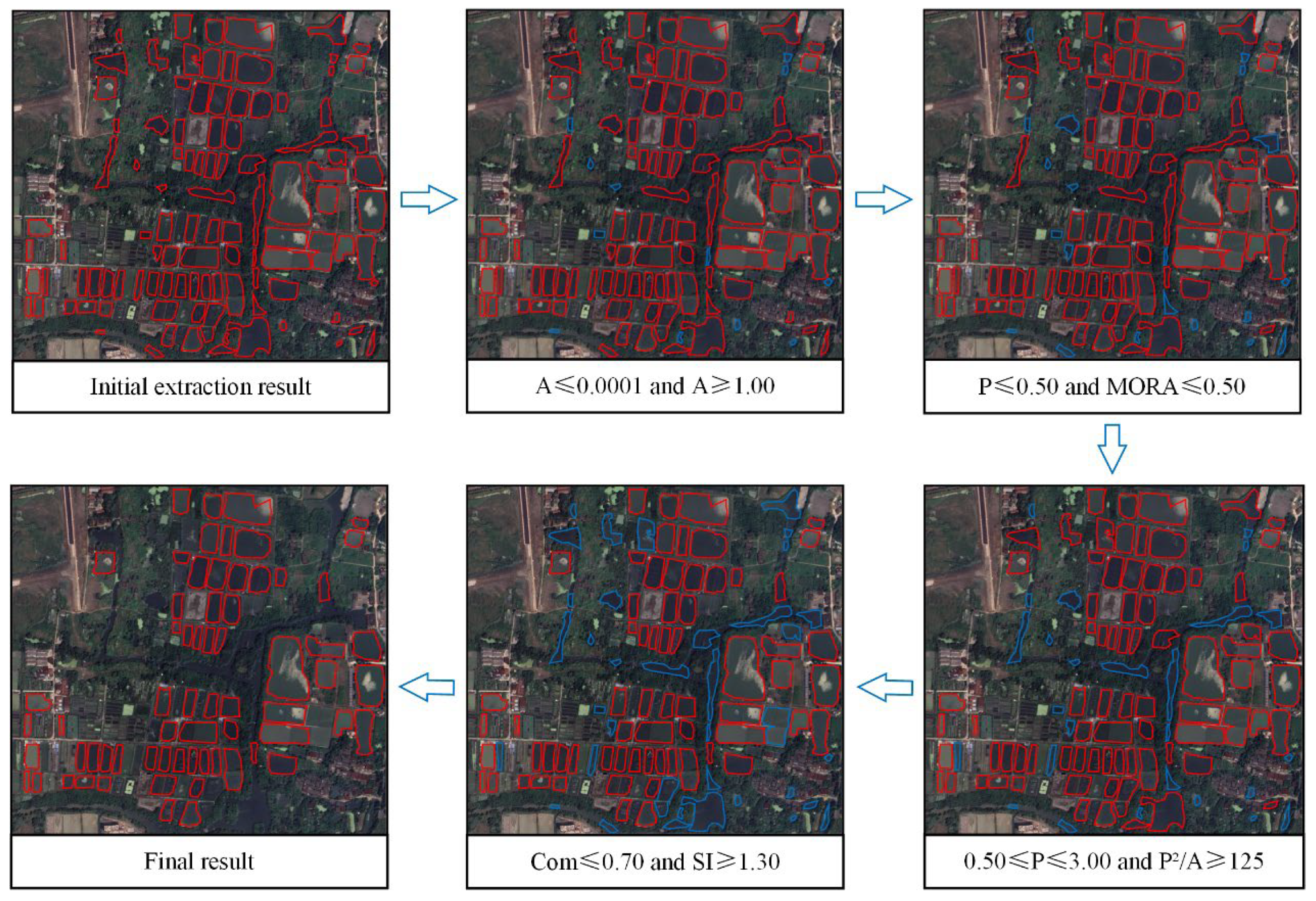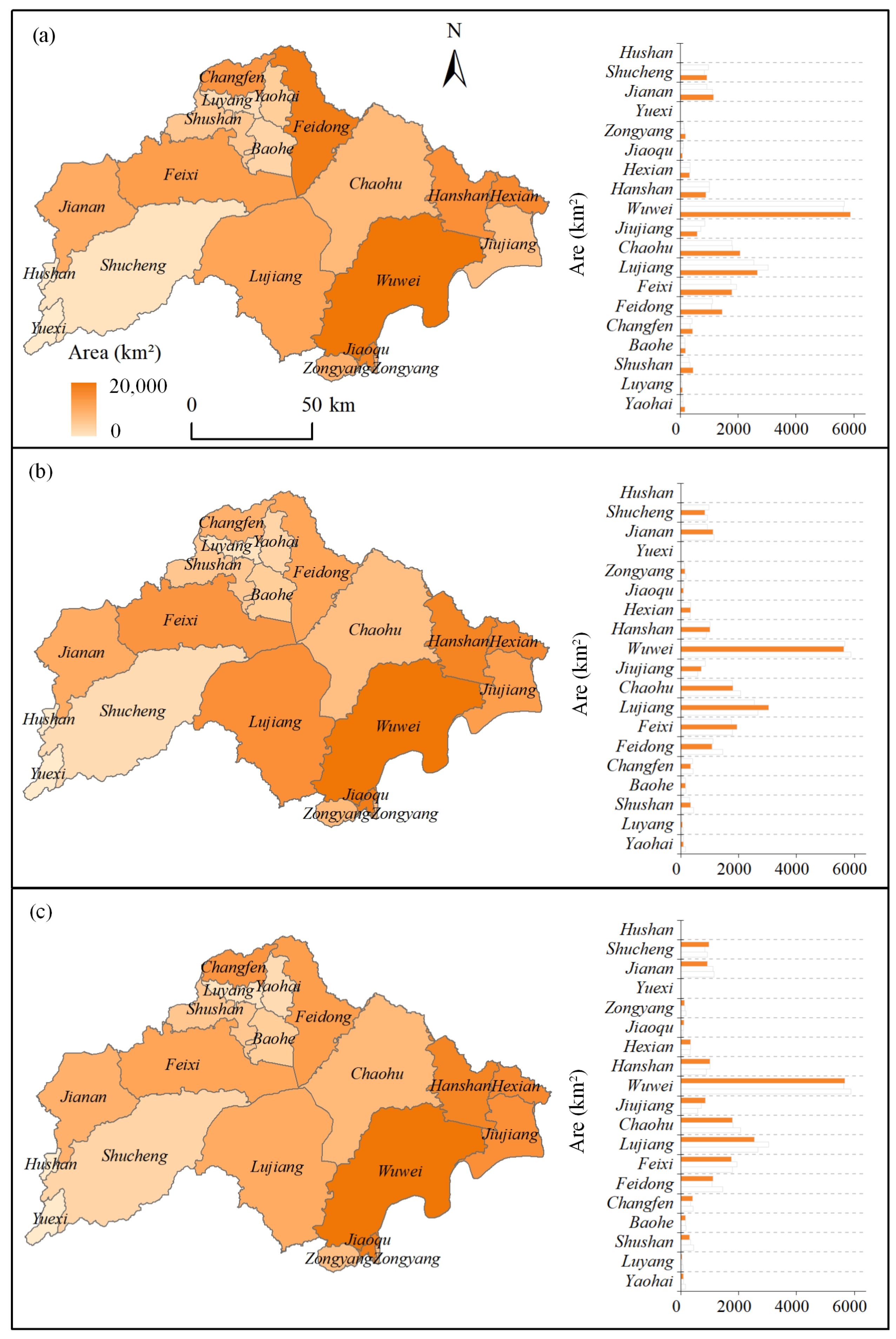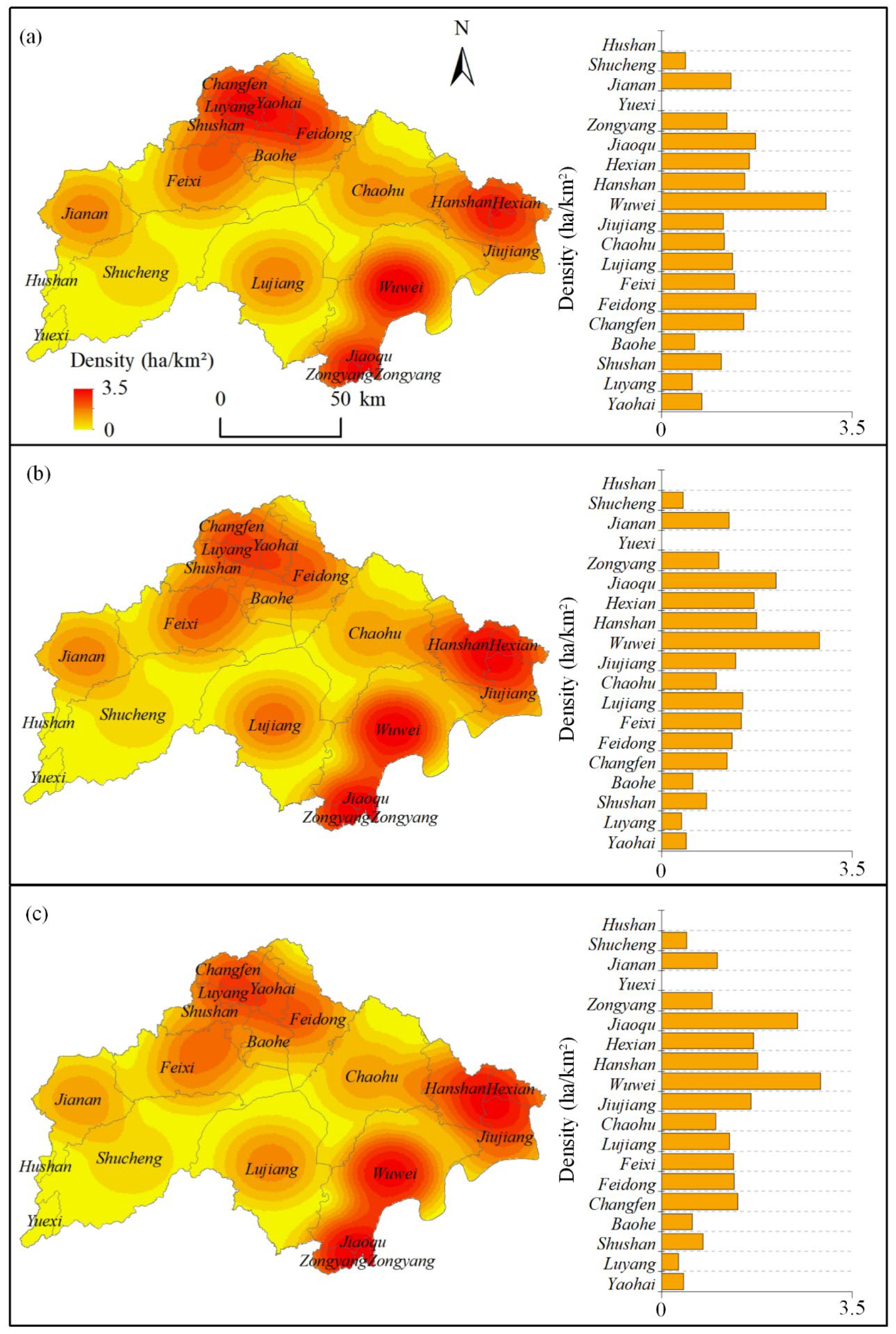A Multi-Source Object-Oriented Framework for Extracting Aquaculture Ponds: A Case Study from the Chaohu Lake Basin, China
Abstract
1. Introduction
2. Materials and Methods
2.1. Study Area and Datasets
2.2. Modelling Framework
2.2.1. Data Preprocessing and Crude Water Extraction
2.2.2. Threshold Segmentation
2.2.3. Fine Extraction
2.2.4. Accuracy Evaluation
2.2.5. Spatiotemporal Analysis
3. Results
3.1. Framework Application
3.2. Spatial Characteristics of Aquaculture Ponds
4. Discussion
4.1. Advantages and Disadvantages of the Framework
4.2. Portability of the Framework
4.3. Implications for Sustainable Management of Aquaculture and Ecosystem Conservation
5. Conclusions
Author Contributions
Funding
Data Availability Statement
Conflicts of Interest
References
- Ottinger, M.; Clauss, K.; Kuenzer, C. Aquaculture: Relevance, distribution, impacts and spatial assessments—A review. Ocean. Coast. Manag. 2016, 119, 244–266. [Google Scholar] [CrossRef]
- Sun, Z.; Luo, J.; Gu, X.; Qi, T.; Xiao, Q.; Shen, M.; Ma, J.; Zeng, Q.; Duan, H. Policy-driven opposite changes of coastal aquaculture ponds between China and Vietnam: Evidence from Sentinel-1 images. Aquaculture 2023, 571, 739474. [Google Scholar] [CrossRef]
- Yao, H. Characterizing landuse changes in 1990–2010 in the coastal zone of Nantong, Jiangsu province, China. Ocean. Coast. Manag. 2013, 71, 108–115. [Google Scholar] [CrossRef]
- Bohnes, F.A.; Laurent, A. Environmental impacts of existing and future aquaculture production: Comparison of technologies and feed options in Singapore. Aquaculture 2021, 532, 736001. [Google Scholar] [CrossRef]
- Nguyen, T.T.N.; Némery, J.; Gratiot, N.; Strady, E.; Tran, V.Q.; Nguyen, A.T.; Aimé, J.; Peyne, A. Nutrient dynamics and eutrophication assessment in the tropical river system of Saigon—Dongnai (southern Vietnam). Sci. Total Environ. 2019, 653, 370–383. [Google Scholar] [CrossRef]
- Hukom, V.; Nielsen, R.; Asmild, M.; Nielsen, M. Do Aquaculture Farmers Have an Incentive to Maintain Good Water Quality? The Case of Small-Scale Shrimp Farming in Indonesia. Ecol. Econ. 2020, 176, 106717. [Google Scholar] [CrossRef]
- Yu, L.; Gan, J. Mitigation of Eutrophication and Hypoxia through Oyster Aquaculture: An Ecosystem Model Evaluation off the Pearl River Estuary. Environ. Sci. Technol. 2021, 55, 5506–5514. [Google Scholar] [CrossRef]
- Thomsen, E.; Herbeck, L.S.; Jennerjahn, T.C. The end of resilience: Surpassed nitrogen thresholds in coastal waters led to severe seagrass loss after decades of exposure to aquaculture effluents. Mar. Environ. Res. 2020, 160, 104986. [Google Scholar] [CrossRef]
- Cui, L.; Li, G.; Ouyang, N.; Mu, F.; Yan, F.; Zhang, Y.; Huang, X. Analyzing Coastal Wetland Degradation and its Key Restoration Technologies in the Coastal Area of Jiangsu, China. Wetlands 2018, 38, 525–537. [Google Scholar] [CrossRef]
- Ren, C.; Wang, Z.; Zhang, Y.; Zhang, B.; Chen, L.; Xi, Y.; Xiao, X.; Doughty, R.; Liu, M.; Jia, M.; et al. Rapid expansion of coastal aquaculture ponds in China from Landsat observations during 1984–2016. Int. J. Appl. Earth Obs. Geoinf. 2019, 82, 101902. [Google Scholar] [CrossRef]
- Duan, Y.; Li, X.; Zhang, L.; Chen, D.; Liu, S.A.; Ji, H. Mapping national-scale aquaculture ponds based on the Google Earth Engine in the Chinese coastal zone. Aquaculture 2020, 520, 734666. [Google Scholar] [CrossRef]
- Duan, Y.; Li, X.; Zhang, L.; Liu, W.; Liu, S.A.; Chen, D.; Ji, H. Detecting spatiotemporal changes of large-scale aquaculture ponds regions over 1988-2018 in Jiangsu Province, China using Google Earth Engine. Ocean. Coast. Manag. 2020, 188, 105144. [Google Scholar] [CrossRef]
- Ottinger, M.; Clauss, K.; Kuenzer, C. Large-Scale Assessment of Coastal Aquaculture Ponds with Sentinel-1 Time Series Data. Remote Sens. 2017, 9, 440. [Google Scholar] [CrossRef]
- Prasad, K.A.; Ottinger, M.; Wei, C.; Leinenkugel, P. Assessment of Coastal Aquaculture for India from Sentinel-1 SAR Time Series. Remote Sens. 2019, 11, 357. [Google Scholar] [CrossRef]
- Gusmawati, N.; Soulard, B.; Selmaoui-Folcher, N.; Proisy, C.; Mustafa, A.; Le Gendre, R.; Laugier, T.; Lemonnier, H. Surveying shrimp aquaculture pond activity using multitemporal VHSR satellite images—Case study from the Perancak estuary, Bali, Indonesia. Mar. Pollut. Bull. 2018, 131, 49–60. [Google Scholar] [CrossRef]
- Peng, Y.; Sengupta, D.; Duan, Y.; Chen, C.; Tian, B. Accurate mapping of Chinese coastal aquaculture ponds using biophysical parameters based on Sentinel-2 time series images. Mar. Pollut. Bull. 2022, 181, 113901. [Google Scholar] [CrossRef]
- Zeng, Z.; Wang, D.; Tan, W.; Huang, J. Extracting aquaculture ponds from natural water surfaces around inland lakes on medium resolution multispectral images. Int. J. Appl. Earth Obs. Geoinf. 2019, 80, 13–25. [Google Scholar] [CrossRef]
- Hou, Y.; Zhao, G.; Chen, X.; Yu, X. Improving Satellite Retrieval of Coastal Aquaculture Pond by Adding Water Quality Parameters. Remote Sens. 2022, 14, 3306. [Google Scholar] [CrossRef]
- Zou, Z.; Chen, C.; Liu, Z.; Zhang, Z.; Liang, J.; Chen, H.; Wang, L. Extraction of Aquaculture Ponds along Coastal Region Using U2-Net Deep Learning Model from Remote Sensing Images. Remote Sens. 2022, 14, 4001. [Google Scholar] [CrossRef]
- Virdis, S.G.P. An object-based image analysis approach for aquaculture ponds precise mapping and monitoring: A case study of Tam Giang-Cau Hai Lagoon, Vietnam. Environ. Monit. Assess. 2014, 186, 117–133. [Google Scholar] [CrossRef]
- Jayanthi, M.; Thirumurthy, S.; Nagaraj, G.; Muralidhar, M.; Ravichandran, P. Spatial and temporal changes in mangrove cover across the protected and unprotected forests of India. Estuar. Coast. Shelf Sci. 2018, 213, 81–91. [Google Scholar] [CrossRef]
- Fan, J.; Zhao, J.; An, W.; Hu, Y. Marine Floating Raft Aquaculture Detection of GF-3 PolSAR Images Based on Collective Multikernel Fuzzy Clustering. IEEE J. Sel. Top. Appl. Earth Obs. Remote Sens. 2019, 12, 2741–2754. [Google Scholar] [CrossRef]
- Geng, X.; Li, X.M.; Jia, T. Automatic Extraction of Marine Aquaculture Areas Based on the Semantic Segmentation Network from GF-3 SAR Data. In Proceedings of the IGARSS 2022–2022 IEEE International Geoscience and Remote Sensing Symposium, Kuala Lumpur, Malaysia, 17–22 July 2022; pp. 5164–5167. [Google Scholar] [CrossRef]
- Yu, J.; He, X.; Yang, P.; Motagh, M.; Xu, J.; Xiong, J. Coastal Aquaculture Extraction Using GF-3 Fully Polarimetric SAR Imagery: A Framework Integrating UNet++ with Marker-Controlled Watershed Segmentation. Remote Sens. 2023, 15, 2246. [Google Scholar] [CrossRef]
- Ottinger, M.; Clauss, K.; Kuenzer, C. Opportunities and Challenges for the Estimation of Aquaculture Production Based on Earth Observation Data. Remote Sens. 2018, 10, 1076. [Google Scholar] [CrossRef]
- Tian, P.; Liu, Y.; Li, J.; Pu, R.; Cao, L.; Zhang, H.; Ai, S.; Yang, Y. Mapping Coastal Aquaculture Ponds of China Using Sentinel SAR Images in 2020 and Google Earth Engine. Remote Sens. 2022, 14, 5372. [Google Scholar] [CrossRef]
- Liang, J.; Liu, D. A local thresholding approach to flood water delineation using Sentinel-1 SAR imagery. ISPRS J. Photogramm. Remote Sens. 2020, 159, 53–62. [Google Scholar] [CrossRef]
- Singha, M.; Dong, J.; Zhang, G.; Xiao, X. High resolution paddy rice maps in cloud-prone Bangladesh and Northeast India using Sentinel-1 data. Sci. Data 2019, 6, 26. [Google Scholar] [CrossRef]
- Liu, C.; Xu, J.; Xu, K.; Yu, J. Mapping large-scale aquaculture ponds in Jiangsu Province, China: An automatic extraction framework based on Sentinel-1 time-series imagery. Aquaculture 2024, 581, 740441. [Google Scholar] [CrossRef]
- Chen, S.; Huang, W.; Chen, Y.; Feng, M. An Adaptive Thresholding Approach toward Rapid Flood Coverage Extraction from Sentinel-1 SAR Imagery. Remote Sens. 2021, 13, 4899. [Google Scholar] [CrossRef]
- Ottinger, M.; Bachofer, F.; Huth, J.; Kuenzer, C. Mapping Aquaculture Ponds for the Coastal Zone of Asia with Sentinel-1 and Sentinel-2 Time Series. Remote Sens. 2022, 14, 153. [Google Scholar] [CrossRef]
- Sun, Z.; Luo, J.; Yang, J.; Yu, Q.; Zhang, L.; Xue, K.; Lu, L. Nation-Scale Mapping of Coastal Aquaculture Ponds with Sentinel-1 SAR Data Using Google Earth Engine. Remote Sens. 2020, 12, 3086. [Google Scholar] [CrossRef]
- Li, B.; Gong, A.; Chen, Z.; Pan, X.; Li, L.; Li, J.; Bao, W. An Object-Oriented Method for Extracting Single-Object Aquaculture Ponds from 10 m Resolution Sentinel-2 Images on Google Earth Engine. Remote Sens. 2023, 15, 856. [Google Scholar] [CrossRef]
- Chen, Y.; He, X.; Wang, J.; Xiao, R. The Influence of Polarimetric Parameters and an Object-Based Approach on Land Cover Classification in Coastal Wetlands. Remote Sens. 2014, 6, 12575–12592. [Google Scholar] [CrossRef]
- Perin, V.; Tulbure, M.G.; Gaines, M.D.; Reba, M.L.; Yaeger, M.A. A multi-sensor satellite imagery approach to monitor on-farm reservoirs. Remote Sens. Environ. 2022, 270, 112796. [Google Scholar] [CrossRef]
- Wang, Z.; Zhang, J.; Yang, X.; Huang, C.; Su, F.; Liu, X.; Liu, Y.; Zhang, Y. Global mapping of the landside clustering of aquaculture ponds from dense time-series 10 m Sentinel-2 images on Google Earth Engine. Int. J. Appl. Earth Obs. Geoinf. 2022, 115, 103100. [Google Scholar] [CrossRef]
- Xia, Z.; Guo, X.; Chen, R. Automatic extraction of aquaculture ponds based on Google Earth Engine. Ocean. Coast. Manag. 2020, 198, 105348. [Google Scholar] [CrossRef]
- Wang, M.; Mao, D.; Xiao, X.; Song, K.; Jia, M.; Ren, C.; Wang, Z. Interannual changes of coastal aquaculture ponds in China at 10-m spatial resolution during 2016–2021. Remote Sens. Environ. 2023, 284, 113347. [Google Scholar] [CrossRef]
- Min, M.; Li, H.; Ma, T.; Miao, C. Will agricultural land scale management aggravate non-point source pollution?—Chaohu Lake Basin, China as a case study. Appl. Geogr. 2023, 158, 103056. [Google Scholar] [CrossRef]
- Duan, Y.; Tian, B.; Li, X.; Liu, D.; Sengupta, D.; Wang, Y.; Peng, Y. Tracking changes in aquaculture ponds on the China coast using 30 years of Landsat images. Int. J. Appl. Earth Obs. Geoinf. 2021, 102, 102383. [Google Scholar] [CrossRef]
- Otsu, N. A Threshold Selection Method from Gray-Level Histograms. IEEE Trans. Syst. Man Cybern. 1979, 9, 62–66. [Google Scholar] [CrossRef]
- Samet, H. Connected Component Labeling Using Quadtrees. Assoc. Comput. Mach. 1981, 28, 487–501. [Google Scholar] [CrossRef]
- Ren, C.; Wang, Z.; Zhang, B.; Li, L.; Chen, L.; Song, K.; Jia, M. Remote Monitoring of Expansion of Aquaculture Ponds Along Coastal Region of the Yellow River Delta from 1983 to 2015. Chin. Geogr. Sci. 2018, 28, 430–442. [Google Scholar] [CrossRef]
- Chen, Y.Q.; Nixon, M.S.; Thomas, D.W. Statistical geometrical features for texture classification. Pattern Recognit. 1995, 28, 537–552. [Google Scholar] [CrossRef]
- Dehua, M.; Zongming, W.; Baojia, D.; Lin, L.; Yanlin, T.; Mingming, J.; Yuan, Z.; Kaishan, S.; Ming, J.; Yeqing, W. National wetland mapping in China: A new product resulting from object-based and hierarchical classification of Landsat 8 OLI images. ISPRS J. Photogramm. Remote Sens. 2020, 164, 11–25. [Google Scholar] [CrossRef]







| Category | Name | Time Period | Spatial Resolution | Source |
|---|---|---|---|---|
| Remote sensing image | Sentinel-1 SAR and Sentinel-2 | 2016, 2020, 2023 | 10 m | European Space Agency |
| DEM | SRTM V3 | 2000 | 30 m | National Aeronautics and Space Administration (NASA) |
| Other auxiliary data | Global Surface Water Mapping Layers | 2020 | 30 m | EC JRC (European Commission’s Joint Research Centre) |
| Global urban boundary | 2020 | 30 m | Star Cloud Data Service Platform | |
| Statistical data | Anhui Provincial Statistical Yearbook | 2017–2022 | / | Anhui Provincial Bureau of Statistics |
| China Fishery Statistical Yearbook | 2017–2022 | / | Ministry of Agriculture and Rural Affairs of the People’s Republic of China |
| Feature/Metric | Description | References |
|---|---|---|
| Area (A) | The coverage range of a specific feature or target in a two-dimensional geographic space | [44] |
| Perimeter (P) | The total length of closed boundaries of a specific feature or target in two-dimensional geographic space | |
| Shape index (SI) | Combining the perimeter and area of the ground features, the regularity of the target boundary is reflected | [45] |
| Compactness (Com) | Compare the perimeter and area of the target object to evaluate its similarity to a circle | [32] |
| Perimeter2/Area (P2/A) | Perimeter to area ratio | / |
| MORA | Minimum outlying rectangular area ratio | / |
| Year | Class | Aquaculture | Non-Aquaculture | UA/% | PA/% | OA/% | Kappa/% |
|---|---|---|---|---|---|---|---|
| 2016 | Aquaculture | 495 | 17 | 96.68 | 88.55 | 92.11 | 84.23 |
| Non-Aquaculture | 64 | 451 | 87.57 | 96.37 | |||
| 2020 | Aquaculture | 493 | 14 | 97.24 | 89.80 | 93.18 | 86.38 |
| Non-Aquaculture | 56 | 464 | 89.23 | 97.07 | |||
| 2023 | Aquaculture | 503 | 15 | 97.10 | 89.50 | 92.79 | 85.58 |
| Non-Aquaculture | 59 | 450 | 88.41 | 96.77 |
| Techniques | Sensor | Accuracy | Study Area | Process | Reference |
|---|---|---|---|---|---|
| Object-oriented method | Sentinel-1 SAR | Overall accuracy 93% | Jiangsu Province, China | Object-based methods and multi-threshold segmentation for aquaculture pond extraction | [29] |
| Object-oriented method | Sentinel-2 | Relative error 1.13% | Northwest Province, Sri Lanka | An iterative water body segmentation algorithm integrating grayscale morphology and edge detection | [33] |
| Object-oriented method | Sentinel-1 SAR | Overall accuracy 90.16% | Vietnam | Time series Sentinel-1 SAR images, threshold segmentation, combined with object-oriented methods | [32] |
| SVM classification method | Landsat OLI, Landsat TM, GaoFen-1 WFV | Overall accuracy 94% | Hubei Province, China | SVM classification method to extract natural and aquaculture ponds | [17] |
| Edge Detection | Sentinel-2 | Overall accuracy 83.91 % | Global scale | Sentinel-2 time series, edge detection, morphology | [36] |
| Decision tree classifier | Landsat 5 T1_SR, Landsat 8 T1_SR | Overall accuracy higher than 91% | Jiangsu Province, China | Extraction of aquaculture ponds by decision trees combined with shape index | [11] |
| Decision tree classifier | Landsat 8 T1_SR | Overall accuracy 96% | Jiangsu Province, China | Extraction of aquaculture ponds by decision trees combined with water index | [12] |
| Threshold segmentation | Sentinel-1 SAR | Overall accuracy 83% | The Mekong Delta, Red River Delta, Pearl River Delta, Yellow River Delta | Time series Sentinel-1 data, water threshold segmentation | [13] |
| Object-oriented method | Sentinel-1 SAR, Sentinel-2 | Overall accuracy 91.90% | Coastal Asia | Object-oriented methods based on multiple sensors | [31] |
| Biophysical parameters | Sentinel-2 | Overall accuracy 91% | Coastal China | A method combining spatial characteristics and biophysical parameters | [16] |
| Object-oriented method | Sentinel-1 SAR | Overall accuracy 89% | Coastal India | Open-source connected component segmentation algorithm | [14] |
| Object-oriented method | Landsat TM | Overall accuracy 92.90% | Coastal China | Integrate updated approach with object-oriented methods | [10] |
| Object-oriented method | Sentinel-1 SAR | Overall accuracy higher than 90% | Coast of China and Vietnam | Combining neighborhood discrimination and morphological features | [2] |
| Threshold segmentation | Sentinel-1 SAR | Overall accuracy 93% | Coastal China | Water index combined with object-oriented extraction methods | [26] |
| Hierarchical decision trees | Sentinel-2 | Overall accuracy higher than 90% | Coastal China | A hybrid approach combining noniterative clustering with hierarchical decision trees | [38] |
| Deep learning | GF-3 | F1 greater than 94% | East coast of Jiangsu Province, China | Mark-controlled watershed method combined with UN++ method | [24] |
Disclaimer/Publisher’s Note: The statements, opinions and data contained in all publications are solely those of the individual author(s) and contributor(s) and not of MDPI and/or the editor(s). MDPI and/or the editor(s) disclaim responsibility for any injury to people or property resulting from any ideas, methods, instructions or products referred to in the content. |
© 2025 by the authors. Licensee MDPI, Basel, Switzerland. This article is an open access article distributed under the terms and conditions of the Creative Commons Attribution (CC BY) license (https://creativecommons.org/licenses/by/4.0/).
Share and Cite
Qi, L.; Wang, Z.; Dai, L.; Wu, F.; Yin, H.; Zhang, K.; Guo, M.; Ye, L.; Zhang, S. A Multi-Source Object-Oriented Framework for Extracting Aquaculture Ponds: A Case Study from the Chaohu Lake Basin, China. Water 2025, 17, 1406. https://doi.org/10.3390/w17091406
Qi L, Wang Z, Dai L, Wu F, Yin H, Zhang K, Guo M, Ye L, Zhang S. A Multi-Source Object-Oriented Framework for Extracting Aquaculture Ponds: A Case Study from the Chaohu Lake Basin, China. Water. 2025; 17(9):1406. https://doi.org/10.3390/w17091406
Chicago/Turabian StyleQi, Lingyan, Zhengxin Wang, Liuyi Dai, Fengwen Wu, Han Yin, Kejia Zhang, Mingzhu Guo, Liangtao Ye, and Shanshan Zhang. 2025. "A Multi-Source Object-Oriented Framework for Extracting Aquaculture Ponds: A Case Study from the Chaohu Lake Basin, China" Water 17, no. 9: 1406. https://doi.org/10.3390/w17091406
APA StyleQi, L., Wang, Z., Dai, L., Wu, F., Yin, H., Zhang, K., Guo, M., Ye, L., & Zhang, S. (2025). A Multi-Source Object-Oriented Framework for Extracting Aquaculture Ponds: A Case Study from the Chaohu Lake Basin, China. Water, 17(9), 1406. https://doi.org/10.3390/w17091406





